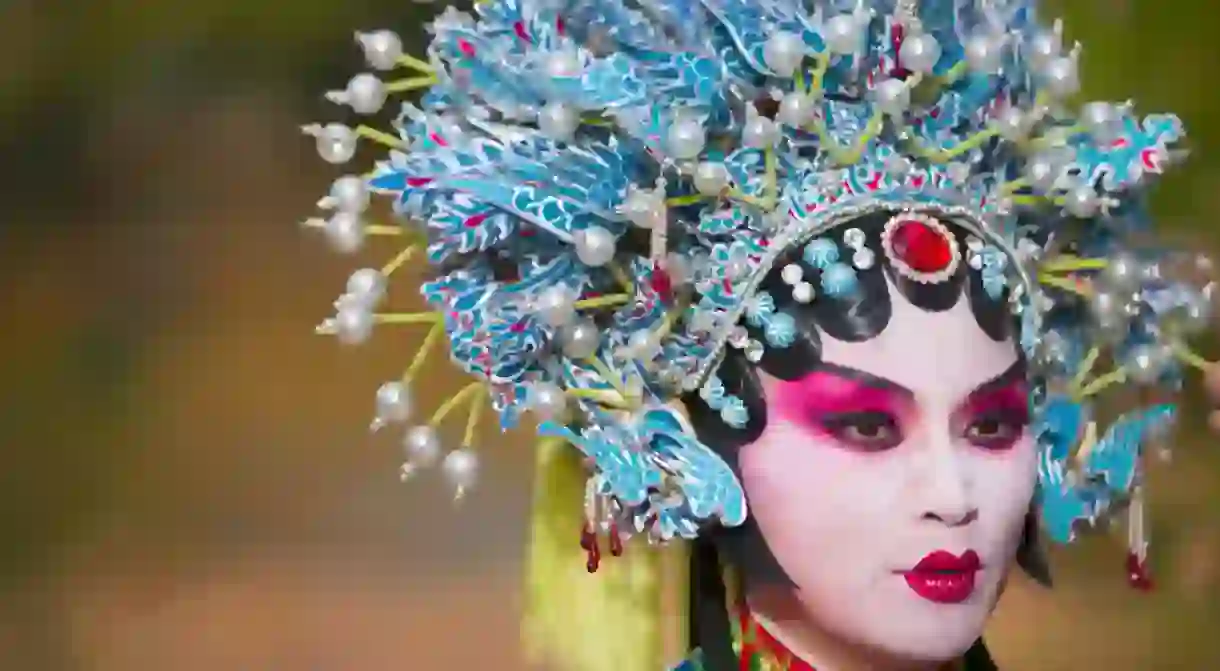The History Of Peking Opera

Peking opera is a form of traditional Chinese theatre that originated in The Chinese capital, Beijing, in the late 18th century. Compared to other types of Chinese theatre, it is a relatively new artform, combining music, song, dance and acrobatics in a lively vivacious display.
Known locally as jīngjù (京剧) Peking opera is commonly understood to have been born in 1790, the year of the Qianlong Emperor’s 80th birthday and midway through the Qing dynasty (1644-1911). Before then, educated nobility preferred the elegant and refined style of Kunqu Opera, which is better known for its singing, strong lyricism and gentle dance movements. However, from the end of the 18th century, Peking, or Beijing opera as it’s now known introduced additional elements, with mime, martial arts and acrobatics added to performances along with instrumental music and singing.
In 1790 four drama troupes from the Anhui province arrived at the capital to perform for the imperial court in celebration of Qianlong’s birthday. This was the first time that regional theatre had been performed in the capital. Those same four troupes later came to be known as the ‘four great Anhui companies,’ and they dominated the Peking opera scene for the next century, along with several troupes from Hubei, who helped fully create the artform by 1845.

In its first incarnations, all the actors were men, with female roles played by young boys. However, that has since changed and women and men are now seen performing in theatres throughout China and beyond. Most of the stories they tell fall into two main categories – wen, or civil theatre, which focuses on love, marriage and other civilian matters, and wu, or military theater, which revolved around the theme of war. The latter tends to feature more acrobatics, while the former is known to use music and song to tell its tales.
By the mid 19th century, jingju was so popular that a theatre district had been established in the centre of Beijing, just south of the Imperial City. The playhouses were popular meeting places and also functioned as tea houses, where patrons were served drinks and snacks while they enjoyed the shows. The performances were popular with high society as well as the public, with the powerful Empress Dowager Cixi (1835-1908) among the most ardent fans of the opera. She even had two stages built in the Summer Palace, as well as a smaller stage in her private quarters, and often summoned the city’s most gifted artists to the royal palace to perform for her.
However, the theatre district lived a short life, as all of Beijing’s theatres were destroyed in 1900 during the Boxer Rebellion, including two of the original ‘four great Anhui companies’ that had survived until that year. In the wake of the destruction, troupes were discontinued, while others created their own newer styles of opera, taking on influences from western dramas and artforms. There were also some who used jingju to spread political messages about social reform.
But it wasn’t all bad news for classical Peking opera, which was taken to other parts of the world, particularly those with large Chinese communities, where it was showcased to brand new audiences, with foreigners fascinated by the unique performances, the likes of which they’d never encountered anywhere before.

It grew in popularity among western audiences during the first half of the twentieth century, thanks in part to actors like Mei Lanfang, who played an important role in introducing Chinese theatre outside of Asia. He performed in the United States in 1930 and Europe in 1935, where he made a particularly strong impression on German dramatist Bertolt Brecht, enough to influence Brecht’s concept of alienation. Mei also created greater equality in the artform and was among the first opera performers to take on female students, which was considered both risky and unconventional at the time.
As well as its exposure to western audiences, historical changes in China also had more of a part to play in its evolution. After the founding of the People’s Republic of China in 1949, performances mainly dealt with contemporary and revolutionary themes, with other topics censored. However, during the Cultural Revolution in the 1960s, all forms of traditional theatre were banned, and artists were regularly humiliated and persecuted by the Red Guards. Yet it underwent a revival during the 1980s and is now once again regularly performed in theatres throughout China, and beyond.
You can witness the unique magic of Peking opera with these tours and experiences in Beijing.
Original article created by Sally Gao.














